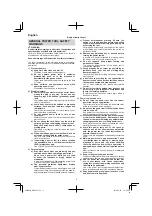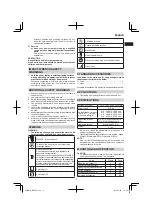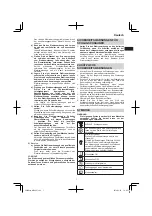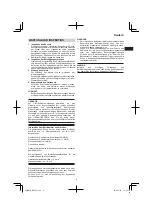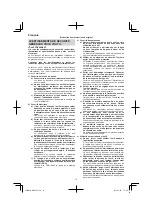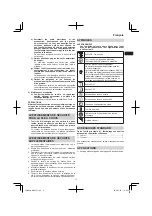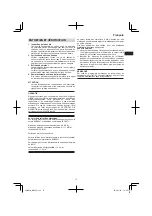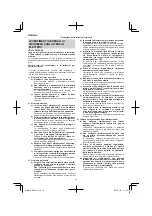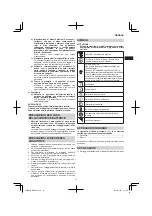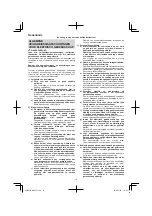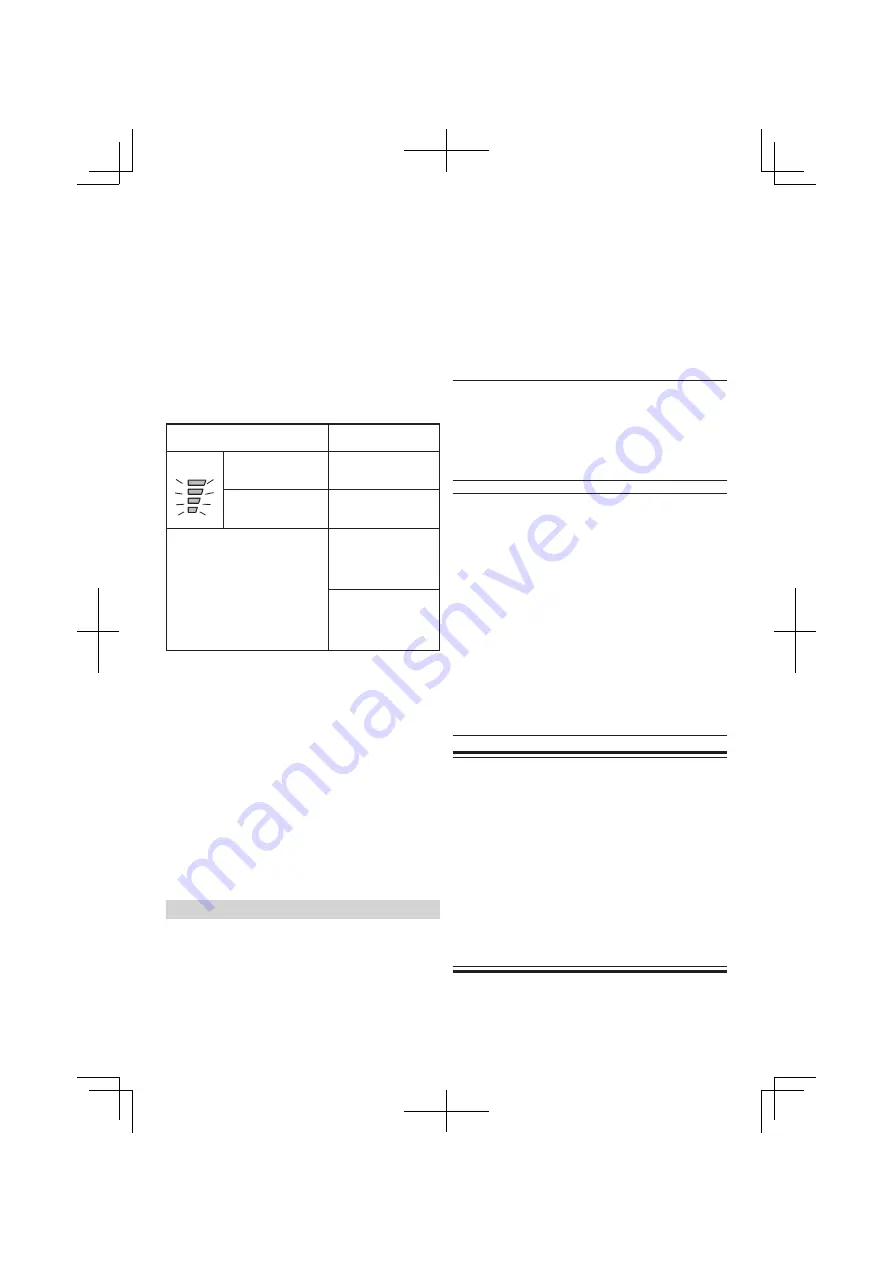
4
English
1. Switch operation (Fig. 4)
○ When the switch trigger (4) is depressed, the tool
rotates. When the trigger is released, the tool stops.
○ The rotational speed can be controlled by varying the
amount that the switch trigger (4) is pulled. Speed is low
when the switch trigger is pulled slightly and increases
as the switch trigger is pulled more.
2. Switching tightening mode (see Fig. 2)
Each press of mode switch (2) will change the impact
rate. Switch (4) must be switched OFF when conducting
this operation. Use A or B for light tasks, and C or D for
heavy tasks.
3. The protection function
To protect the tool, the protection function will be
activated, automatically shutting down the unit in the
event of any problems. (
Table 1
)
Table 1
Mode Indicator Lamp (3)
(see
Fig. 2
)
Cause of Shutdown
Flashing
Fast repeated flashes
Flashes on and off with
0.1-second intervals
Automatic shutdown
initiated by excessive
load (*1)
Slow repeated flashes
Flashes on and off with
1-second intervals
Automatic shutdown
initiated due to sensor
detection trouble (*2)
Flashing during mode operation
Automatic shutdown
initiated due to the tool’s
internal temperature
exceeding the specified
temperature level (*3)
Automatic shutdown
initiated due to
approximately 5 minutes
of continuous no-load
operation (*4)
*1 Excessive load protection function
For excessive load conditions, the tool will shutdown to
prevent damage.
Discontinue the heavy load task and press mode switch
(2) to reset the tool.
*2 Control monitoring function
Press mode switch (2) to reset the tool.
Continual occurrences of this situation may be the result
of damage to the tool.
*3 Increased temperature protection function
Automatic shutdown is activated to prevent damage
from high temperatures.
The tool’s internal temperature will increase for tasks
involving the use of large currents of electricity, or when
used in high temperature environments.
Please allow the tool to rest for 10 to 15 minutes before
continuing a task.
*4 Continuous operation prevention function
Shutdown will occur in the event of continuous operation
while the switch remains ON.
MAINTENANCE AND INSPECTION
1. Inspecting the socket
A worn or deformed hex or a square-holed socket will
not give an adequate tightness to the fitting between the
nut or anvil, consequently resulting in loss of tightening
torque. Pay attention to wear of socket holes periodically,
and replace with a new one if needed.
2. Inspecting the mounting screws
Regularly inspect all mounting screws and ensure that
they are properly tightened. Should any of the screws be
loose, retighten them immediately. Failure to do so could
result in serious hazard.
3. Maintenance of the motor
The motor unit winding is the very “heart” of the power tool.
Exercise due care to ensure the winding does not
become damaged and/or wet with oil or water.
4. Replacing supply cord
If the replacement of the supply cord is necessary, this
has to be done by the manufacturer of this agent in order
to avoid a safety hazard.
CAUTION
In the operation and maintenance of power tools, the
safety regulations and standards prescribed in each
country must be observed.
GUARANTEE
We guarantee HiKOKI Power Tools in accordance with
statutory/country specific regulation. This guarantee does
not cover defects or damage due to misuse, abuse, or
normal wear and tear. In case of complaint, please send
the Power Tool, undismantled, with the GUARANTEE
CERTIFICATE found at the end of this Handling instruction,
to a HiKOKI Authorized Service Center.
IMPORTANT
Correct connection of the plug
The wires of the main lead are coloured in accordance
with the following code:
Blue: — Neutral
Brown: — Live
As the colours of the wires in the main lead of this tool may
not correspond with the coloured markings identifying the
terminals in your plug proceed as follows:
The wire coloured blue must be connected to the terminal
marked with the letter N or coloured black. The wire
coloured brown must be connected to the terminal marked
with the letter L or coloured red. Neither core must be
connected to the earth terminal.
NOTE:
This requirement is provided according to BRITISH
STANDARD 2769: 1984.
Therefore, the letter code and colour code may not be
applicable to other markets except The United Kingdom.
Information concerning airborne noise and vibration
The measured values were determined according to
EN62841 and declared in accordance with ISO 4871.
Measured A-weighted sound power level: 98 dB (A)
Measured A-weighted sound pressure level: 111 dB (A)
Uncertainty K: 3 dB (A).
Wear hearing protection.
Vibration total values (triax vector sum) determined
according to EN62841.
Impact tightening of fasteners of the maximum capacitiy of
the tool:
Vibration emission value
a
h
= 13.2 m/s
2
Uncertainty K = 1.5 m/s
2
The declared vibration total value has been measured in
accordance with a standard test method and may be used
for comparing one tool with another.
It may also be used in a preliminary assessment of exposure.
0000Book_WR14VE.indb 4
2019/03/05 16:45:10


